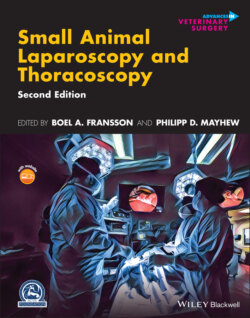Читать книгу Small Animal Laparoscopy and Thoracoscopy - Группа авторов - Страница 18
1930s: The Glory Days
ОглавлениеThe twentieth century saw rapid technology development, which led to more widespread promotion of endoscopy. Paralleled with this development was the improved safety and possibilities of surgical procedures provided by antibiotics, better anesthesia, and blood transfusions. By the 1930s, endo‐urologists had embraced the endoscopy technology with giddy enthusiasm, but surgical application was still lagging behind. Inadequate optics has been stated as one of the major reasons for this stall in progress.
Figure 1 Bozzini’s Lichtleiter, a vase‐shaped, leather‐covered tin lantern using a wax candle light source.
Source: Courtesy of Dr. David C. Twedt.
Enter the German gastroenterologist Heinz Kalk (1895–1973), who in 1929 introduced a foreoblique lens system, which effectively increased the field of vision. Kalk is considered by many to be the greatest clinical laparoscopists of all times. He was disturbed by the contemporary high fatality rates associated with liver biopsies, and he was the first to introduce a safe and accurate method of endoscopic biopsies of liver, gallbladder, and kidney. With Kalk's improvements, the increased usefulness of the scope invigorated surgeons to start using the technology. Before Kalk, endoscopy had mainly been applied by gynecologists and urologists. Kalk was fortunate to, just barely, make it out alive during the Stalingrad invasion of 1943. His survival was fortunate to the development of laparoscopy, because the highly productive physician continued his prolific scientific publishing and research well into the 1950s. During the 1950s, he began collaborating with Karl Storz in the development of instrumentation.
Another landmark in the 1930s was when the Hungarian physician Janos Veress developed a novel spring‐loaded needle 1937. The needle was originally used to perform therapeutic pneumothorax to treat patients suffering from tuberculosis. However, laparoscopists quickly realized its potential for safe creation of pneumoperitoneum [2].
Meanwhile, back in America, John Ruddock (1891–1961), an internist from Los Angeles, was most likely the principle driving force behind the acceptance of laparoscopy in the United States during the 1930s and beyond. Ruddock was known to work tirelessly to advocate for the laparoscope and to make a plea to internists and surgeons to work more cooperatively toward the goal of bringing minimally invasive care to patients. With his “peritoneoscope,” he was able to diagnose patients with metastatic gastric carcinoma by minimally invasive means, sparing them a nontherapeutic and thus wasted laparotomy, as metastatic disease was considered non‐operable at the time.
By the end of the 1930s, operative laparoscopic procedures were finally in more general clinical use, and no longer reserved for a few dedicated centers. However, paralleled with this development was also rising death rates from endoscopy complications. Some of the early pioneer physicians were visionary enough to comment on “the need for doctors to essentially retrain themselves” as an important impediment to general acceptance of laparoscopy.
